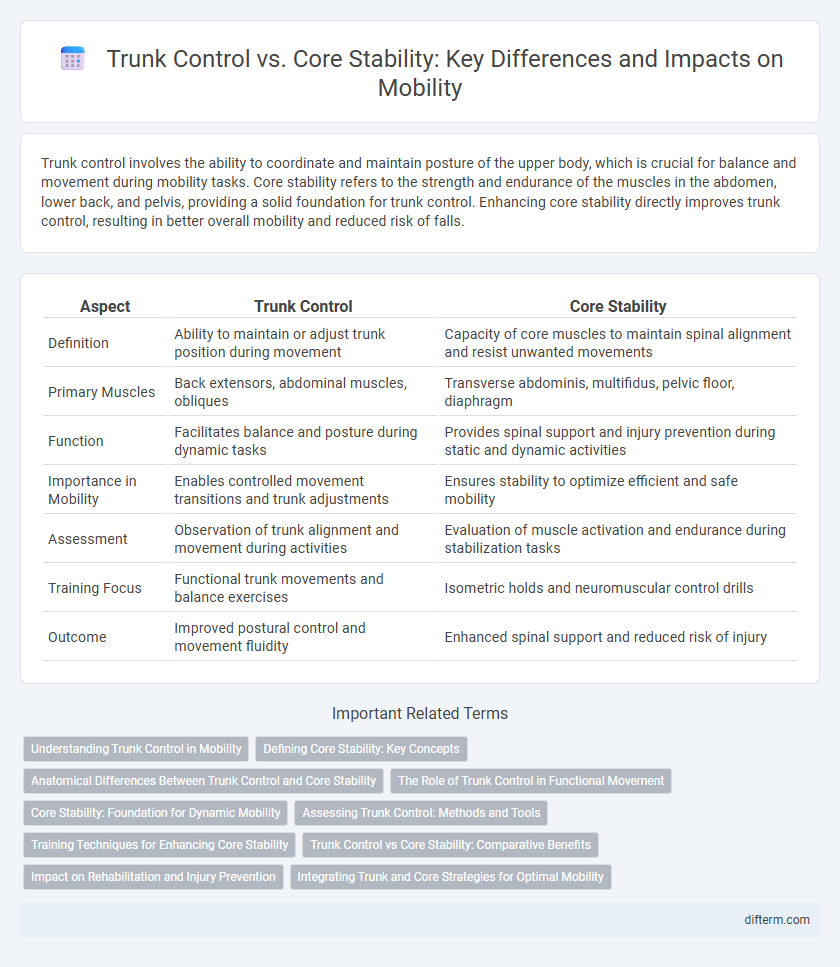Trunk control involves the ability to coordinate and maintain posture of the upper body, which is crucial for balance and movement during mobility tasks. Core stability refers to the strength and endurance of the muscles in the abdomen, lower back, and pelvis, providing a solid foundation for trunk control. Enhancing core stability directly improves trunk control, resulting in better overall mobility and reduced risk of falls.
Table of Comparison
| Aspect | Trunk Control | Core Stability |
|---|---|---|
| Definition | Ability to maintain or adjust trunk position during movement | Capacity of core muscles to maintain spinal alignment and resist unwanted movements |
| Primary Muscles | Back extensors, abdominal muscles, obliques | Transverse abdominis, multifidus, pelvic floor, diaphragm |
| Function | Facilitates balance and posture during dynamic tasks | Provides spinal support and injury prevention during static and dynamic activities |
| Importance in Mobility | Enables controlled movement transitions and trunk adjustments | Ensures stability to optimize efficient and safe mobility |
| Assessment | Observation of trunk alignment and movement during activities | Evaluation of muscle activation and endurance during stabilization tasks |
| Training Focus | Functional trunk movements and balance exercises | Isometric holds and neuromuscular control drills |
| Outcome | Improved postural control and movement fluidity | Enhanced spinal support and reduced risk of injury |
Understanding Trunk Control in Mobility
Trunk control is essential for mobility as it coordinates the muscles around the spine and pelvis to maintain balance and posture during movement. Unlike general core stability, which emphasizes strength and endurance, trunk control specifically involves dynamic adjustments that support functional activities such as walking, reaching, and transferring. Effective trunk control enhances motor control, reduces compensatory patterns, and improves overall mobility outcomes in rehabilitation and daily function.
Defining Core Stability: Key Concepts
Core stability refers to the ability of the muscles in the trunk, pelvis, and lower back to maintain proper alignment and control during dynamic movements, ensuring efficient force transfer and balance. Key components include muscular endurance, neuromuscular control, and strength of deep stabilizing muscles such as the transverse abdominis and multifidus. Effective core stability enhances trunk control by providing a solid foundation for limb movement, reducing injury risk and improving overall mobility performance.
Anatomical Differences Between Trunk Control and Core Stability
Trunk control primarily involves the coordinated activation of the thoracic and lumbar spine muscles, including the erector spinae, multifidus, and abdominal muscles, to maintain posture and balance during movement. Core stability emphasizes the deep stabilizing muscles such as the transverse abdominis, pelvic floor muscles, and diaphragm, which create intra-abdominal pressure to protect the spine and enhance segmental control. Anatomically, trunk control targets dynamic postural adjustments through superficial and intermediate muscle layers, while core stability relies on deep neuromuscular activation for spinal stiffness and injury prevention.
The Role of Trunk Control in Functional Movement
Trunk control is essential for functional movement as it provides a stable base for limb actions, enhancing balance and coordination during dynamic activities. Effective trunk control improves posture, reduces compensatory movement patterns, and supports efficient force transfer between the upper and lower body. Core stability, while important, serves as a foundation that enables precise trunk control necessary for complex motor tasks and injury prevention.
Core Stability: Foundation for Dynamic Mobility
Core stability serves as the essential foundation for dynamic mobility by maintaining proper alignment and control of the spine duringmovement. Enhanced core stability improves balance, reduces the risk of injury, and allows efficient force transfer between the upper and lower body. Unlike trunk control, which focuses on segmental movement of the torso, core stability emphasizes integrated muscle activation for overall postural support and functional mobility.
Assessing Trunk Control: Methods and Tools
Assessing trunk control involves evaluating the ability to maintain posture and coordinate movements through standardized clinical tools such as the Trunk Impairment Scale (TIS) and Pressure Biofeedback Units (PBU). Quantitative methods include motion analysis systems and electromyography to measure muscle activation and movement patterns. Accurate assessment of trunk control provides critical data for designing effective rehabilitation protocols targeting core stability and overall mobility enhancement.
Training Techniques for Enhancing Core Stability
Training techniques for enhancing core stability emphasize dynamic exercises such as planks, Pilates, and functional movements that engage multiple muscle groups including the transverse abdominis, multifidus, and pelvic floor. Incorporating proprioceptive challenges like unstable surfaces or balance boards enhances neuromuscular coordination crucial for trunk control. Progressive overload and consistency in these targeted exercises improve muscle endurance and postural alignment, supporting efficient mobility and reducing injury risk.
Trunk Control vs Core Stability: Comparative Benefits
Trunk control enhances dynamic balance and coordination, crucial for activities requiring limb movement and postural adjustments, while core stability provides a solid foundation by strengthening deep muscles that support the spine. Improved trunk control facilitates efficient functional mobility and reduces fall risk, especially in populations with neurological impairments. Core stability training complements this by promoting spinal alignment and endurance, collectively optimizing overall mobility and injury prevention.
Impact on Rehabilitation and Injury Prevention
Trunk control enhances dynamic balance and gait efficiency, crucial for effective rehabilitation after musculoskeletal injuries. Core stability reinforces spinal alignment and load distribution, reducing the risk of recurrent injury and improving functional mobility. Integrating trunk control and core stability training optimizes recovery outcomes and supports long-term injury prevention strategies.
Integrating Trunk and Core Strategies for Optimal Mobility
Integrating trunk control with core stability enhances overall mobility by improving balance, coordination, and functional movement patterns. Effective trunk control stabilizes the spine and pelvis, allowing core muscles to generate and transfer force efficiently during dynamic activities. Combining these strategies supports injury prevention and maximizes performance in both daily tasks and athletic movements.
Trunk control vs Core stability Infographic

 difterm.com
difterm.com